Applicability of Hydropower Generation and Pumped Hydro Energy Storage in the Middle East and North Africa
Abstract
1. Introduction
2. Introduction to Hydropower and Pumped Hydro Storage
- Topographic conditions that provide sufficient water head between upper and lower reservoirs;
- Strong geotechnical sites where no avalanches or landslides are expected;
- Availability of sufficient quantities of water;
- Access to electrical transmission networks.
3. Global Hydropower Projects
4. Case Studies of Projects from the MENA Region
4.1. Ethiopia Hydropower
Future Project in Ethiopia
4.2. Egypt
4.2.1. Aswan Low Dam
4.2.2. Esna Dam
4.2.3. HPP Assiut
4.2.4. Aswan High Dam
4.2.5. Naga Hammadi
Future Projects in Egypt
4.3. Sudan
Future Projects in Sudan
4.4. Morocco
4.5. Algeria
4.6. Tunisia
4.7. UAE Projects and Potential
5. Hydropower Economical Point of Views
6. Discussion
7. Conclusions and Future Work
Author Contributions
Funding
Institutional Review Board Statement
Informed Consent Statement
Data Availability Statement
Conflicts of Interest
References
- Alami, A.H. Introduction to Mechanical Energy Storage BT. In Mechanical Energy Storage for Renewable and Sustainable Energy Resources; Alami, A.H., Ed.; Springer International Publishing: Cham, Switzerland, 2020; pp. 1–12. ISBN 978-3-030-33788-9. [Google Scholar]
- Hai Alami, A. Analytical and Experimental Evaluation of Energy Storage Using Work of Buoyancy Force. J. Renew. Sustain. Energy 2014, 6, 013137. [Google Scholar] [CrossRef]
- Olabi, A.G.; Saleh, B.A.; Abdelghafar, A.A.; Baroutaji, A.; Sayed, E.T.; Alami, A.H.; Rezk, H.; Abdelkareem, M.A. Large-Vscale Hydrogen Production and Storage Technologies: Current Status and Future Directions. Int. J. Hydrogen Energy 2020, 46, 23498–23528. [Google Scholar] [CrossRef]
- Sharjah Electricity Water and Gas Authority SEWA. The Annual Statistical Book; SEWA: Sharjah, United Arab Emirates, 2020. [Google Scholar]
- Abdelkareem, M.A.; Elsaid, K.; Wilberforce, T.; Kamil, M.; Sayed, E.T.; Olabi, A. Environmental Aspects of Fuel Cells: A Review. Sci. Total Environ. 2021, 752, 141803. [Google Scholar] [CrossRef] [PubMed]
- Child, M.; Kemfert, C.; Bogdanov, D.; Breyer, C. Flexible Electricity Generation, Grid Exchange and Storage for the Transition to a 100% Renewable Energy System in Europe. Renew. Energy 2019, 139, 80–101. [Google Scholar] [CrossRef]
- Alami, A.H. General Concepts BT. In Mechanical Energy Storage for Renewable and Sustainable Energy Resources; Alami, A.H., Ed.; Springer International Publishing: Cham, Switzerland, 2020; pp. 13–20. ISBN 978-3-030-33788-9. [Google Scholar]
- Rabaia, M.K.H.; Abdelkareem, M.A.; Sayed, E.T.; Elsaid, K.; Chae, K.-J.; Wilberforce, T.; Olabi, A.G. Environmental Impacts of Solar Energy Systems: A Review. Sci. Total Environ. 2021, 754, 141989. [Google Scholar] [CrossRef]
- Alami, A.H. Thermal Storage. In Mechanical Energy Storage for Renewable and Sustainable Energy Resources; Springer International Publishing: Cham, Switzerland, 2020; pp. 27–34. ISBN 978-3-030-33788-9. [Google Scholar]
- Khan, N.; Dilshad, S.; Khalid, R.; Kalair, A.R.; Abas, N. Review of Energy Storage and Transportation of Energy. Energy Storage 2019, 1, e49. [Google Scholar] [CrossRef]
- Connolly, D.; Lund, H.; Mathiesen, B.; Leahy, M. A Review of Computer Tools for Analysing the Integration of Renewable Energy into Various Energy Systems. Appl. Energy 2010, 87, 1059–1082. [Google Scholar] [CrossRef]
- Gür, T. Review of Electrical Energy Storage Technologies, Materials and Systems: Challenges and Prospects for Large-Scale Grid Storage. Energy Environ. Sci. 2018, 10, 2696–2767. [Google Scholar] [CrossRef]
- Zhao, G.; Davison, M. Optimal Control of Hydroelectric Facility Incorporating Pump Storage. Renew. Energy 2009, 34, 1064–1077. [Google Scholar] [CrossRef]
- Alami, A.H. Pumped Hydro Storage BT. In Mechanical Energy Storage for Renewable and Sustainable Energy Resources; Alami, A.H., Ed.; Springer International Publishing: Cham, Switzerland, 2020; pp. 51–65. ISBN 978-3-030-33788-9. [Google Scholar]
- Uría-Martínez, R.; Johnson, M.; O’Connor, P. 2017 Hydropower Market Report; Department of Energy, Water Power Technologies Office: Washington, DC, USA, 2018. [Google Scholar]
- Abdellatif, D.; AbdelHady, R.; Ibrahim, A.; El-Zahab, E. Conditions for Economic Competitiveness of Pumped Storage Hydroelectric Power Plants in Egypt. Renew. Wind Water Sol. 2018, 5, 1. [Google Scholar] [CrossRef]
- Petrescu, R.V.; Petrescu, F.T. Hydropower and Pumped Storage. Alternative Energy Magazine, 26 November 2015. [Google Scholar]
- Whiteman, A.; Rueda, S.; Akande, D.; Elhassan, N.; Escamilla, G.; Arkhipova, I. Renewable Capacity Statistics 2020; IRENA: Abu Dhabi, United Arab Emirates, 2020. [Google Scholar]
- Bowen, T.; Chernyakhovskiy, I.; Xu, K.; Gadzanku, S.; Coney, K. USAID Grid-Scale Energy Storage Technologies Primer; USAID: Washington, DC, USA, 2021. [Google Scholar]
- Stocks, M.; Stocks, R.; Lu, B.; Cheng, C.; Blakers, A. Global Atlas of Closed-Loop Pumped Hydro Energy Storage. Joule 2021, 5, 270–284. [Google Scholar] [CrossRef]
- Jacobson, M.Z.; Delucchi, M.A.; Bauer, Z.A.F.; Goodman, S.C.; Chapman, W.E.; Cameron, M.A.; Bozonnat, C.; Chobadi, L.; Clonts, H.A.; Enevoldsen, P. 100% Clean and Renewable Wind, Water, and Sunlight All-Sector Energy Roadmaps for 139 Countries of the World. Joule 2017, 1, 108–121. [Google Scholar] [CrossRef]
- International Renewable Energy Agency. Renewable Capacity Statistics 2021 Statistiques de Capacité Renouvelable 2021 Estadísticas de Capacidad Renovable 2021; IRENA: Abu Dhabi, United Arab Emirates, 2021; ISBN 9789295111905. [Google Scholar]
- Available online: https://commons.wikimedia.org/wiki/File:MENA.svg (accessed on 1 March 2022).
- Rehman, S.; Al-Hadhrami, L.; MahbubAlam, M. Pumped Hydro Energy Storage System: A Technological Review. Renew. Sustain. Energy Rev. 2015, 44, 586–598. [Google Scholar] [CrossRef]
- Amin, A.Z. Africa 2030: Road Map for a Renewable Energy Future; IRENA: Abu Dhabi, United Arab Emirates, 2015. [Google Scholar]
- Tilahun, M.A. Feasibility Study of Pumped Storage System for Application in Amhara Region, Ethiopia. Master’s Thesis, School of Industrial Engineering and Management (ITM), Energy Technology, Heat and Power Technology, Stockholm, Sweden, 2018. [Google Scholar]
- Ahmed, A.T.; Helmy Elsanabary, M. Hydrological and Environmental Impacts of Grand Ethiopian Renaissance Dam on the Nile River. In Proceedings of the Eighteenth International Water Technology Conference, IWTC, Sharm El-Sheikh, Egypt, 12–14 March 2015; pp. 336–347. [Google Scholar]
- Degefu, D.M.; He, W.; Zhao, J.H. Hydropower for Sustainable Water and Energy Development in Ethiopia. Sustain. Water Resour. Manag. 2015, 314, 305–314. [Google Scholar] [CrossRef]
- Zwaan, B.; Boccalon, A.; Longa, F. Prospects for Hydropower in Ethiopia. Energy Strateg. Rev. 2017, 19, 19–30. [Google Scholar] [CrossRef]
- Moss, S. Weatherwatch: Ethiopia’s Contrasting Altitudes Bring Extreme Rain and Shine. The Guardian, 25 May 2020. [Google Scholar]
- Ingwani, E.; Gumbo, T.; Gondo, T. The General Information about the Impact of Water Hyacinth on Aba Samuel Dam, Addis Ababa, Ethiopia: Implications for Ecohydrologists. Ecohydrol. Hydrobiol. 2010, 10, 341–345. [Google Scholar] [CrossRef]
- Lautze, J.; McCartney, M.; Kirshen, P.; Olana, D.; Jayasinghe, G.; Spielman, A. Effect of a Large Dam on Malaria Risk: The Koka Reservoir in Ethiopia. Trop. Med. Int. Health 2007, 12, 982–989. [Google Scholar] [CrossRef]
- Regasa, M.S.; Nones, M. Effects of Land Cover/Use Changes on the Ethiopian Fincha Dam Capacity. Development 2020, 17, 18. [Google Scholar]
- Devi, R.; Tesfahune, E.; Legesse, W.; Deboch, B.; Beyene, A. Assessment of Siltation and Nutrient Enrichment of Gilgel Gibe Dam, Southwest Ethiopia. Bioresour. Technol. 2008, 99, 975–979. [Google Scholar] [CrossRef]
- Ambelu, A.; Lock, K.; Goethals, P.L.M. Hydrological and Anthropogenic Influence in the Gilgel Gibe I Reservoir (Ethiopia) on Macroinvertebrate Assemblages. Lake Reserv. Manag. 2013, 29, 143–150. [Google Scholar] [CrossRef]
- Zaniolo, M.; Castelletti, A.; Giuliani, M.; Burlando, P. Seasonal Drought Forecasts to Optimally Balancing Multisector Interests during Reservoir Filling Transients. In Proceedings of the AGU Fall Meeting Abstracts, San Francisco, CA, USA, 9–13 December 2019; Volume 2019, p. H23G-08. [Google Scholar]
- Hayicho, H.; Alemu, M.; Kedir, H. Assessment of Land-Use and Land Cover Change Effect on Melka Wakena Hydropower Dam in Melka Wakena Catchment of Sub-Upper Wabe-Shebelle Watershed, South Eastern Ethiopia. Agric. Sci. 2019, 10, 819–840. [Google Scholar] [CrossRef]
- Ali, D.A.; Deininger, K.; Monchuk, D. Using Satellite Imagery to Assess Impacts of Soil and Water Conservation Measures: Evidence from Ethiopia’s Tana-Beles Watershed. Ecol. Econ. 2020, 169, 106512. [Google Scholar] [CrossRef]
- Welde, K.; Gebremariam, B. Effect of Land Use Land Cover Dynamics on Hydrological Response of Watershed: Case Study of Tekeze Dam Watershed, Northern Ethiopia. Int. Soil Water Conserv. Res. 2017, 5, 1–16. [Google Scholar] [CrossRef]
- McCartney, M.P.; Shiferaw, A.; Seleshi, Y. Estimating Environmental Flow Requirements Downstream of the Chara Chara Weir on the Blue Nile River. Hydrol. Process. An Int. J. 2009, 23, 3751–3758. [Google Scholar] [CrossRef]
- Yihdego, Y.; Khalil, A.; Salem, H.S. Nile River’s Basin Dispute: Perspectives of the Grand Ethiopian Renaissance Dam (GERD). Glob. J. Hum. Soc. Sci 2017, 17, 1–21. [Google Scholar]
- Jembere, D.; Yihdego, Y. Engineering Rock Mass Evaluation for a Multi-Purpose Hydroelectric Power Plant: Case of Genale Dawa (GD-3), Ethiopia. Geotech. Geol. Eng. 2016, 34, 1593–1612. [Google Scholar] [CrossRef]
- Gebreyohannes, T.; De Smedt, F.; Walraevens, K.; Gebresilassie, S.; Hussien, A.; Hagos, M.; Amare, K.; Deckers, J.; Gebrehiwot, K. Regional Groundwater Flow Modeling of the Geba Basin, Northern Ethiopia. Hydrogeol. J. 2017, 25, 639–655. [Google Scholar] [CrossRef]
- De Waal, D.J.; Verster, A.; Bloemfontein, S.A. Losses Due to Spillage at Gariep Dam. In Proceedings of the 7th International Probabilistic Workshop, Delft, The Netherlands, 25–26 November 2009; pp. 23–33. [Google Scholar]
- Cook, T. Engineering Modernity: The Aswan Low Dam and Modernizing the Nile. PhD Thesis, Western Oregon University, Monmouth, OR, USA, 2013. [Google Scholar]
- Raslan, Y.; Salama, R. Development of Nile River Islands between Old Aswan Dam and New Esna Barrages. Natl. Water Res. Cent. 2015, 29, 77–92. [Google Scholar] [CrossRef]
- Hill, T.J.F. Assiut Barrage, to Rehabilitate or to Rebuild. In Improvements in Reservoir Construction, Operation and Maintenance, Proceedings of the 14th Conference of the British Dam Society at the University of Durham, Durham, UK, 6–9 September 2006; Thomas Telford Publishing: London, UK, 2006; pp. 224–235. [Google Scholar]
- Abu-Zeid, M.; El-Shibini, Z. Egypt’s High Aswan Dam. Int. J. Water Resour. Dev. 2010, 13, 209–218. [Google Scholar] [CrossRef]
- Sattar, A.; Raslan, Y. Predicting Morphological Changes DS New Naga-Hammadi Barrage for Extreme Nile Flood Flows: A Monte Carlo Analysis. J. Adv. Res. 2014, 5, 97–107. [Google Scholar] [CrossRef]
- Abd-El Monsef, H.; Smith, S.E.; Darwish, K. Impacts of the Aswan High Dam after 50 Years. Water Resour. Manag. 2015, 29, 1873–1885. [Google Scholar] [CrossRef]
- Mansour, B.G.S.; Nashed, N.F.; Mansour, S.G.S. Model Study to Optimize the Hydraulic Performance of the New Naga Hammadi Barrage Stilling Basin. In Proceedings of the Bridging the Gap: Meeting the World’s Water and Environmental Resources Challenges, Orlando, FL, USA, 20–24 May 2001; pp. 1–9. [Google Scholar]
- Rabah, A.; Nimer, H.; Doud, K.; Ahmed, Q. Modelling of Sudan’s Energy Supply, Transformation, and Demand. J. Energy 2016, 2016, 16. [Google Scholar] [CrossRef]
- Bosshard, P. Kajbar Dam Sudan. 2016. Available online: https://www.banktrack.org/project/kajbar_dam/pdf (accessed on 1 March 2022).
- Elgameel, M.; Abdellatif, M. Operation of Roseires and Sennar Dams Using Artificial Neural Network. Master’s Thesis, University of Khartoum, Khartoum, Sudan, 2004. Available online: https://core.ac.uk/download/pdf/71674486.pdf (accessed on 1 March 2022).
- Zoellner, F.; Scheid, Y.; Mukthar, M. Implementation of the Dam Complex at Upper Atbara, Sudan, in Challenging Site Conditions, Environmental Science Conference. 2017. Available online: https://www.semanticscholar.org/paper/Implementation-of-the-Dam-Complex-at-Upper-Atbara%2C-Zoellner-Scheid/57533d5e6c5462e216bda0b2bb5712eb05d85f7a (accessed on 1 March 2022).
- Kajbar, T. Kajbar Dam, Sudan. 2010. “Status Report: Africa-EU Energy Partnership,” European Union Energy Initiative. 2014. Available online: http://www.euei-pdf.org/ (accessed on 1 March 2022).
- Kousksou, T.; Allouhi, A.; Jamil, A.; El Rhafiki, T.; Arid, A.; Zeraouli, Y. Renewable Energy Potential and National Policy Directions for Sustainable Development in Morocco. Renew. Sustain. Energy 2015, 47, 46–57. [Google Scholar] [CrossRef]
- Stambouli, A. An Overview of Different Energy Sources in Algeria. Jordan Engineering Association Conference. 2018. Available online: http://www.jeaconf.org/UploadedFiles/Document/db8b44dd-8036-47ef-a62a-080f35315daa.pdf (accessed on 1 March 2022).
- Euei Pdf on behalf of Aeep. Status Report: Africa-EU Energy Partnership. Eur. Union Energy Initiat. 2014. Available online: https://africa-eu-energy-partnership.org/wp-content/uploads/2020/04/04_150902_euei_aeep_status-report_en_rz_05_web_0.pdf (accessed on 1 March 2022).
- United Nations Industrial Development Organization (UNIDO). World Small Hydropower Development Report 2016; United Nations Industrial Development Organization: Vienna, Austria, 2016; Volume 650. [Google Scholar]
- Remini, B.; Kettab, A.; Hihat, H. Choking up of Ighil Emda Dam with Mud. La Houille Blanche 1995, 1995, 23–31. [Google Scholar] [CrossRef][Green Version]
- Bouraiou, A.; Necaibia, A.; Boutasseta, N.; Mekhilef, S.; Dabou, R.; Ziane, A.; Sahouane, N.; Attoui, I.; Mostefaoui, M.; Touaba, O. Status of Renewable Energy Potential and Utilization in Algeria. J. Clean. Prod. 2020, 246, 119011. [Google Scholar] [CrossRef]
- Ott, J.C. Construction of Bou-Hanifia Dam, Algeria (La Construction Du Barrage de Bou-Hanifia (Algerie)); Britt, S., Translator; U.S. Geological Survey: Reston, VA, USA, 1946. [Google Scholar]
- Remini, B.; Ouidir, K. Le Barrage Reservoir D’erraguene (algerie): Une Experience De Plus D’un Demi-siecle Dans Le Soutirage Des Courants De Densite. Larhyss J. 2017, 14, 213–244. [Google Scholar]
- Gupta, H.K.; Rastogi, B.K. Seismic Reservoir Sites: Their Geology and Seismicity. In Dams and Earthquakes; Chapter 3; Elsevier: Amsterdam, The Netherlands, 1976; Volume 11, pp. 43–117. ISBN 0165-1250. [Google Scholar]
- Ullah, I.; Rasul, M. Recent Developments in Solar Thermal Desalination Technologies: A Review. Energies 2018, 12, 119. [Google Scholar] [CrossRef]
- Nadir, M.; Boualem, R. Study of Beni Haroun Dam Pollution (Algeria). Desalin. Water Treat. 2016, 57, 2766–2774. [Google Scholar] [CrossRef]
- Diaf, M.; Hazzab, A.; Yahiaoui, A.; Belkendil, A. Characterization and Frequency Analysis of Flooding Solid Flow in Semi-Arid Zone: Case of Mekerra Catchment in the North-West of Algeria. Appl. Water Sci. 2020, 10, 59. [Google Scholar] [CrossRef]
- Ghernaout, D.; Benblidia, C.; Khemici, F. Microalgae Removal from Ghrib Dam (Ain Defla, Algeria) Water by Electroflotation Using Stainless Steel Electrodes. Desalin. Water Treat. 2015, 54, 3328–3337. [Google Scholar] [CrossRef]
- Horchani, A. Water in Tunisia: A National Perspective; National Academic Press: Washington, DC, USA, 2007. [Google Scholar]
- UNEP, United Nations Environment Programme. Document Repository, Energy Profile Tunisia. 2021. Available online: https://wedocs.unep.org/bitstream/handle/20.500.11822/20592/Energy_profile_Tunisia.pdf?sequence=1&isAllowed=y (accessed on 1 March 2022).
- Ministry of Energy and Industry. Total Water Accumulated in-MOEI Dams in Million Cubic Meter. 2020. Available online: https://data.bayanat.ae/ar/dataset/total-water-accumulated-in-moei-dams-million-cubic-meter (accessed on 1 March 2022).
- Sanderson, D. UAE Water Resources under “Extreme Stress”, New Report Finds. The National, 8 August 2019. [Google Scholar]
- NS Energy. Hatta Pumped Storage Hydroelectric Project, NS Energy Business. 2019. Available online: https://www.nsenergybusiness.com/projects/hatta-pumped-storage-hydroelectric-project/ (accessed on 1 March 2022).
- Jamil, M.; Ahmad, F.; Jeon, Y.J. Renewable Energy Technologies Adopted by the UAE: Prospects and Challenges–A Comprehensive Overview. Renew. Sustain. Energy Rev. 2016, 55, 1181–1194. [Google Scholar] [CrossRef]
- Gulf News. Mohammed Bin Rashid Al Maktoum Solar Park Launches Third Phase in Dubai. UAE—Gulf News, 12 December 2020. [Google Scholar]
- UAE Energy Strategy 2050—The Official Portal of the UAE Government. 2020. Available online: https://u.ae/en/about-the-uae/strategies-initiatives-and-awards/federal-governments-strategies-and-plans/uae-energy-strategy-2050 (accessed on 1 March 2022).
- “Jebel Ali M-Station, Dubai—UAE’s biggest power and desalination facility,” Power Technology. 2015. Available online: https://www.power-technology.com/projects/jebel-ali-m-station/ (accessed on 1 March 2022).
- DEWA. DEWA Signs MoU with Masdar and EDF for Phase 3 of Mohammed bin Rashid Al Maktoum Solar Park, and with EDF for Hatta Hydroelectric Plant|EDF Middle East. 2017. Available online: https://www.dewa.gov.ae/en/about-us/media-publications/latest-news/2017/11/dewa-signs-mou-with-masdar-and-edf-for-phase-3-of-mohammed-bin-rashid-al-maktoum-solar-park (accessed on 1 March 2022).
- Dubai Pushes Solar Power Cost to World’s Lowest as Largest Single-Site Solar Park Set to Rise. Environment—Gulf News, 19 March 2018.
- Blakers, A.; Stocks, M.; Lu, B.; Cheng, C. A Review of Pumped Hydro Energy Storage. Prog. Energy 2021, 3, 022003. [Google Scholar] [CrossRef]
- IRENA. Renewable Power Generation Costs in 2020; IRENA: Abu Dhabi, United Arab Emirates, 2020; ISBN 978-92-9260-244-4. [Google Scholar]
- Fälth, H.E.; Atsmon, D.; Reichenberg, L.; Verendel, V. MENA Compared to Europe: The Influence of Land Use, Nuclear Power, and Transmission Expansion on Renewable Electricity System Costs. Energy Strateg. Rev. 2021, 33, 100590. [Google Scholar] [CrossRef]
- IRENA. Innovative Operation of Pumped Hydropower Storage Innovation Landscape Brief; IRENA: Abu Dhabi, United Arab Emirates, 2020; pp. 1–24. [Google Scholar]
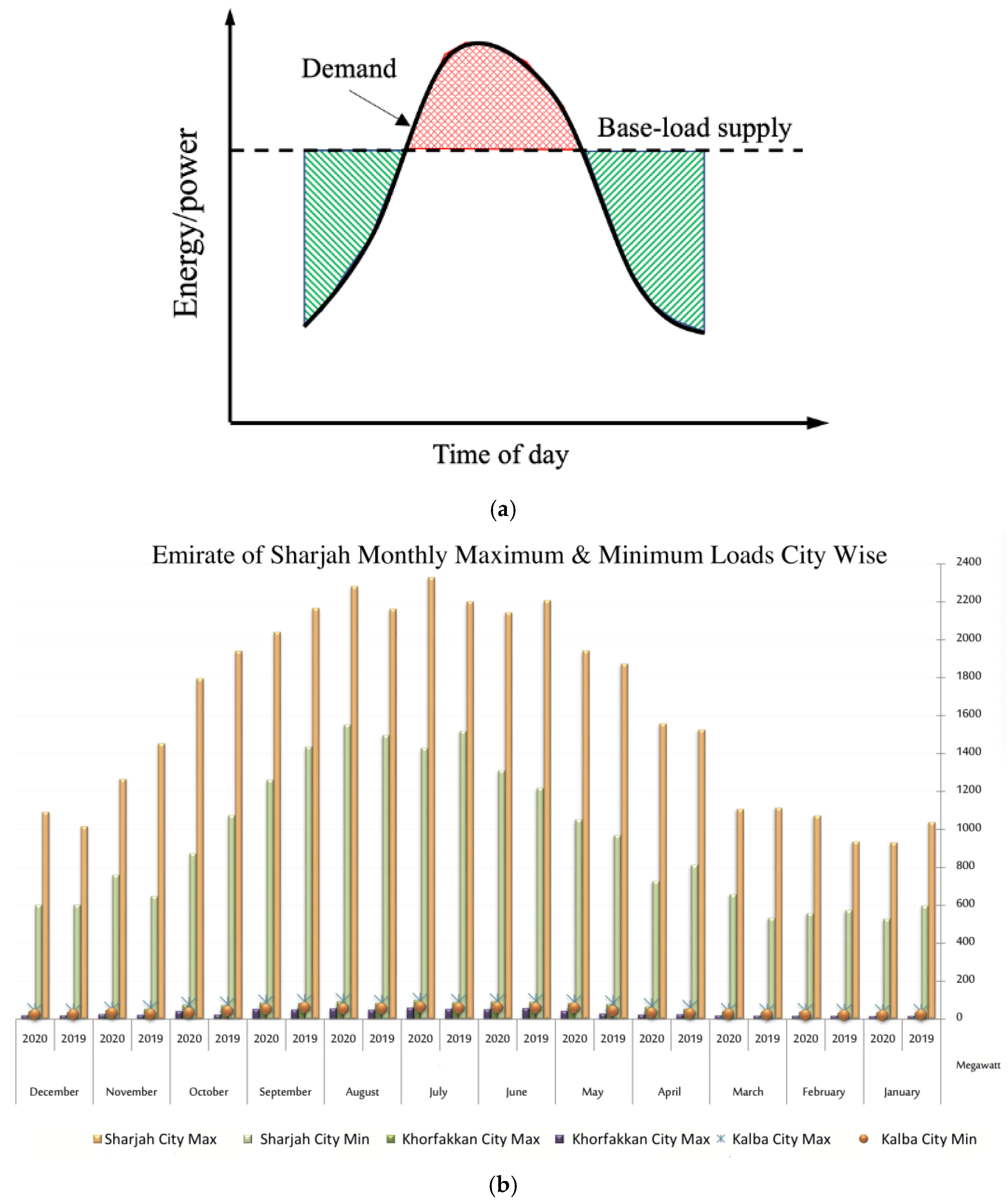
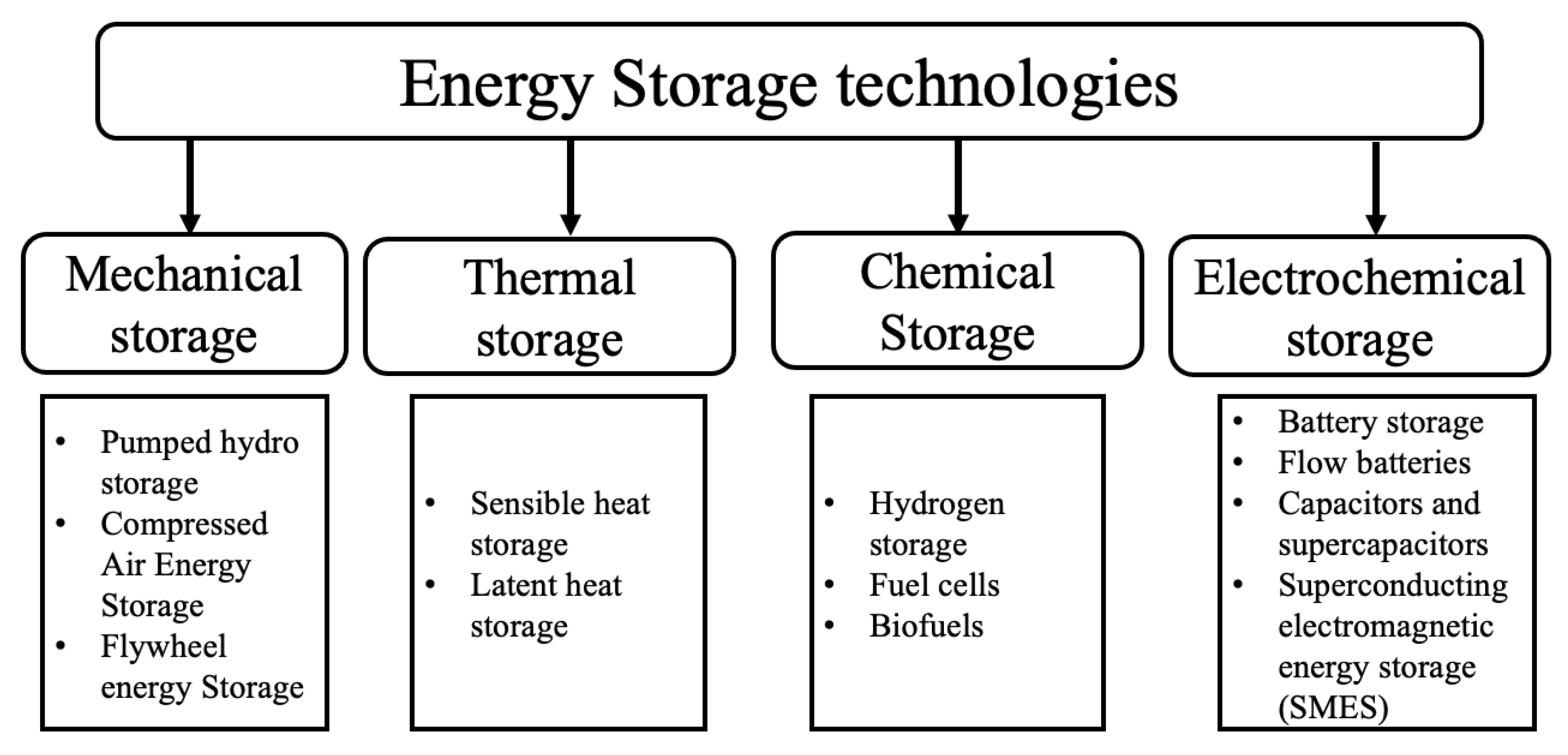
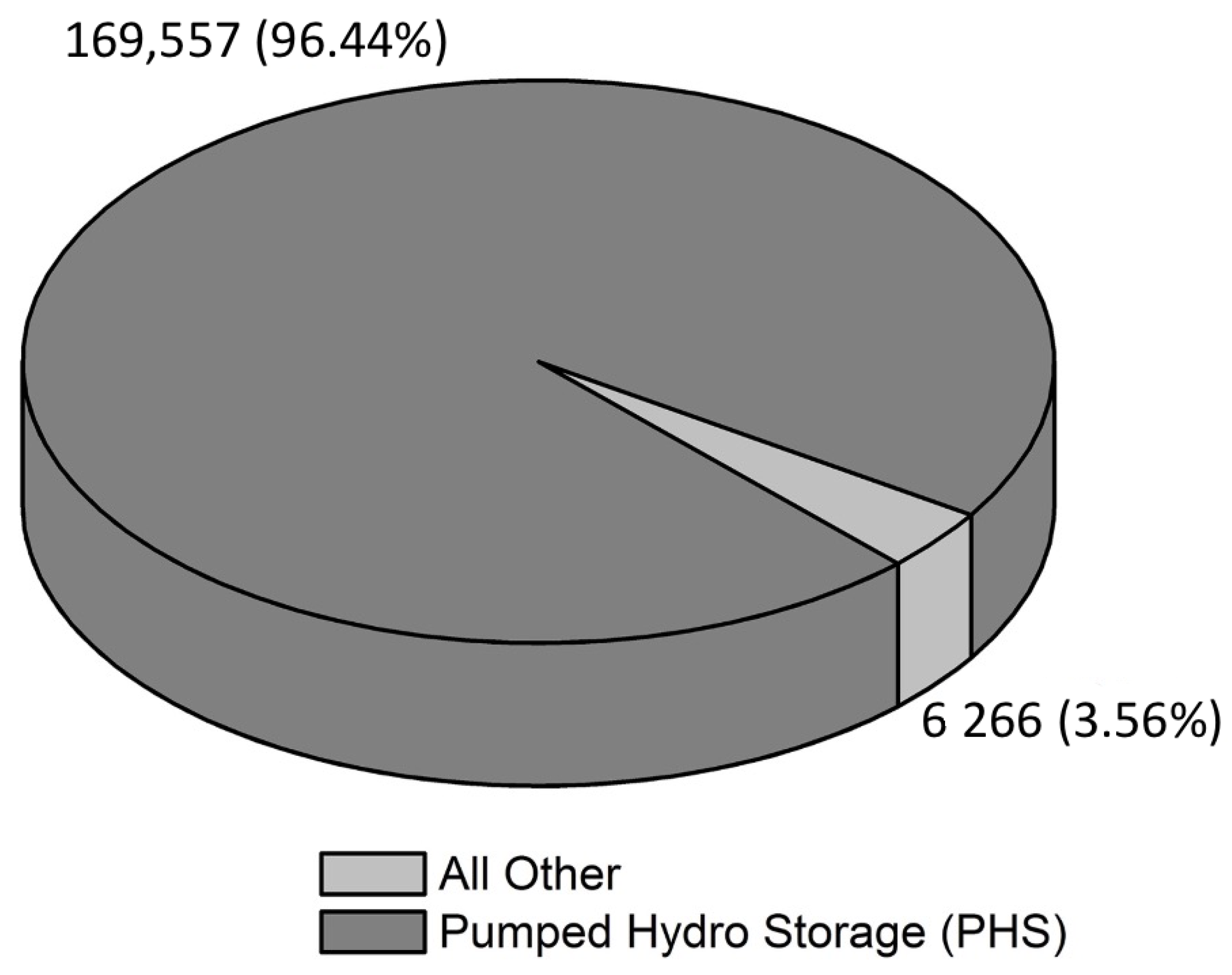

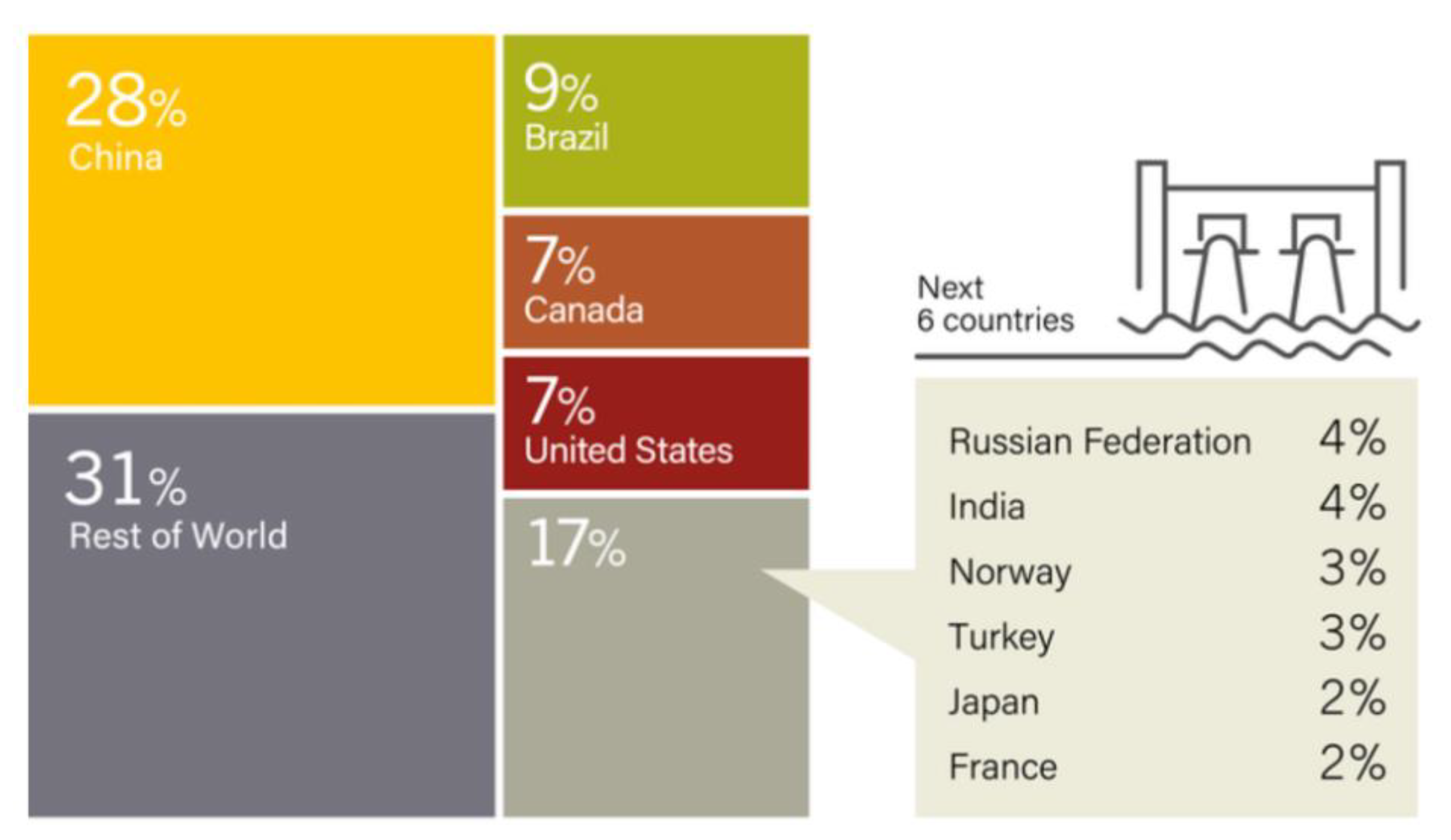
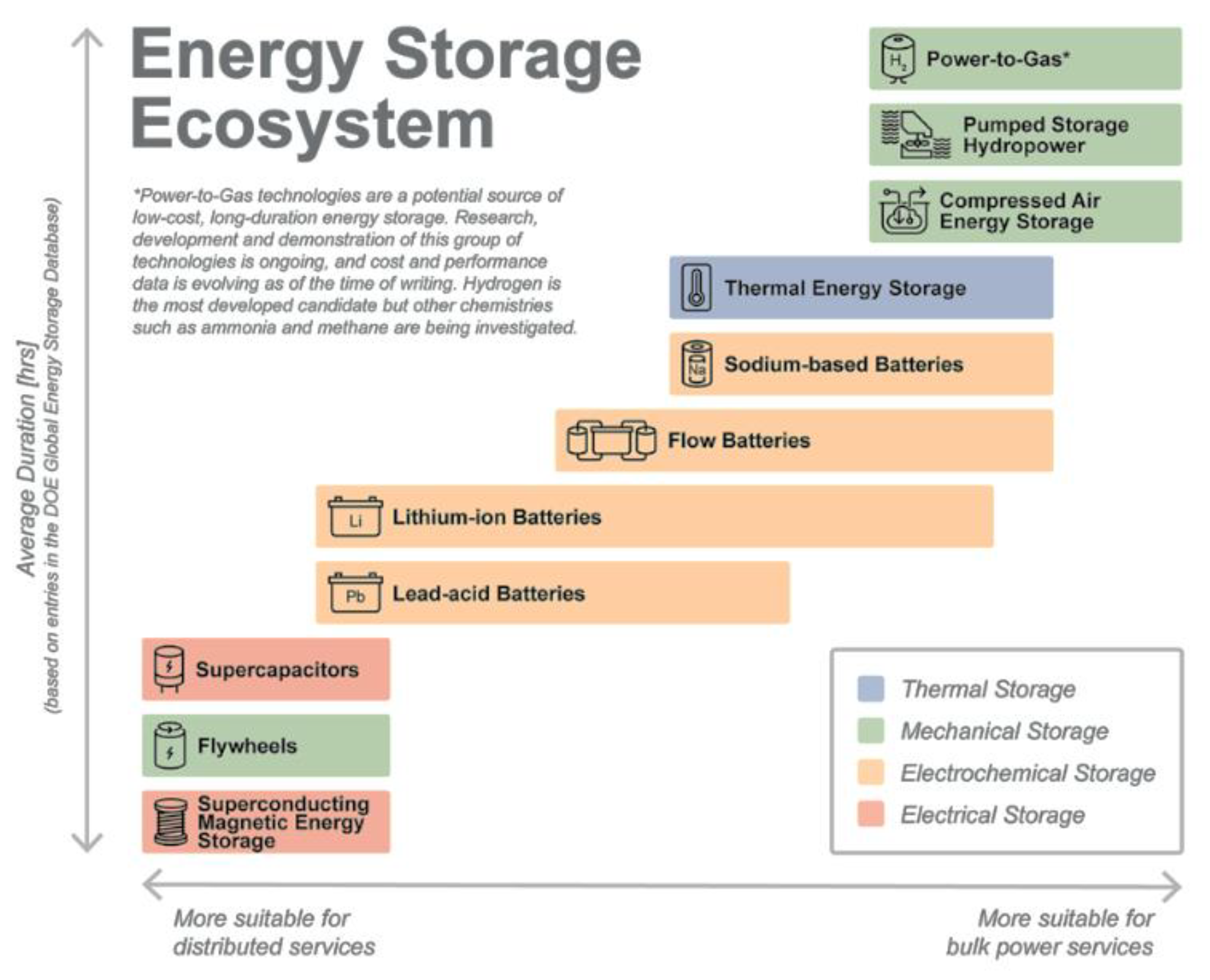
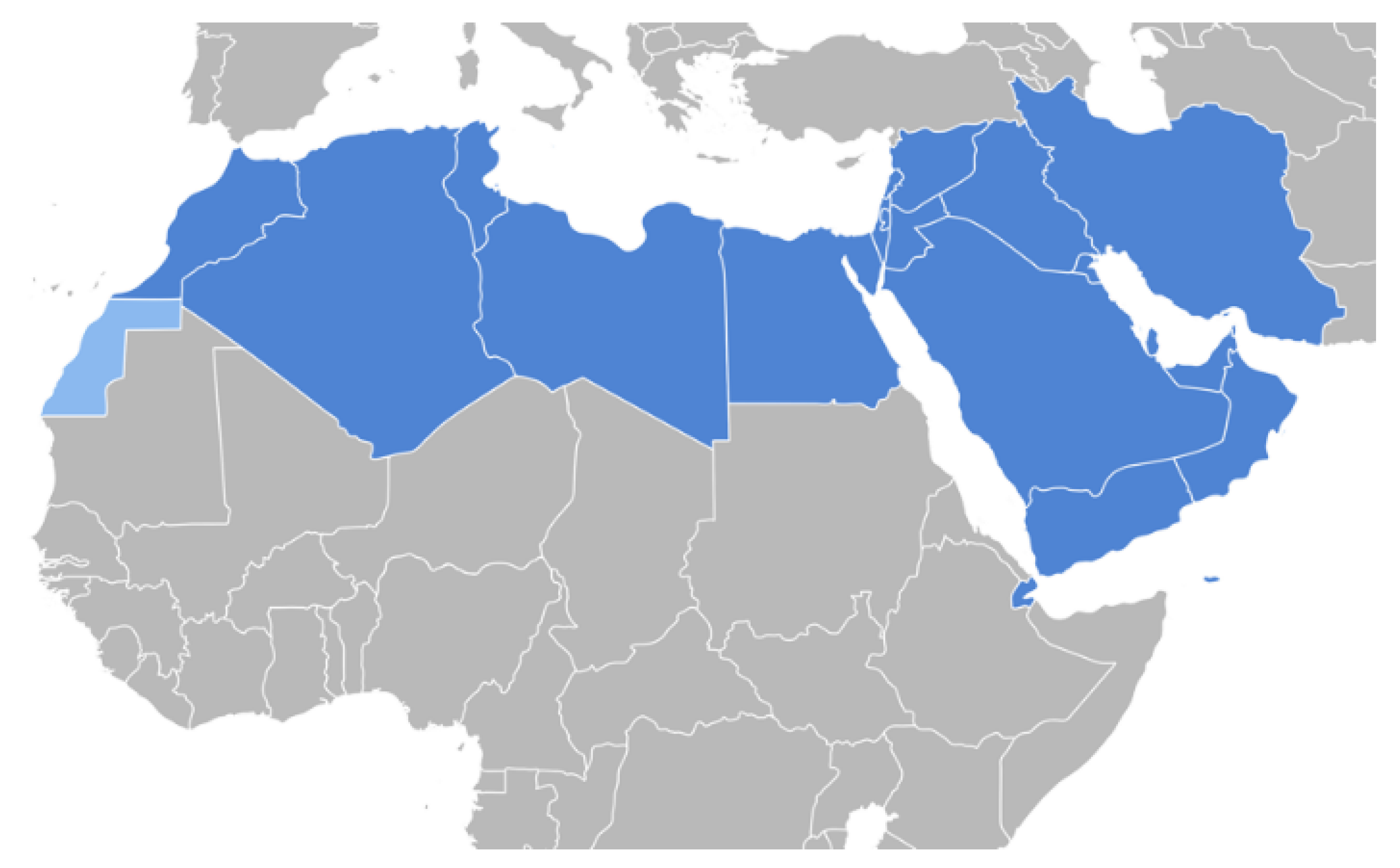
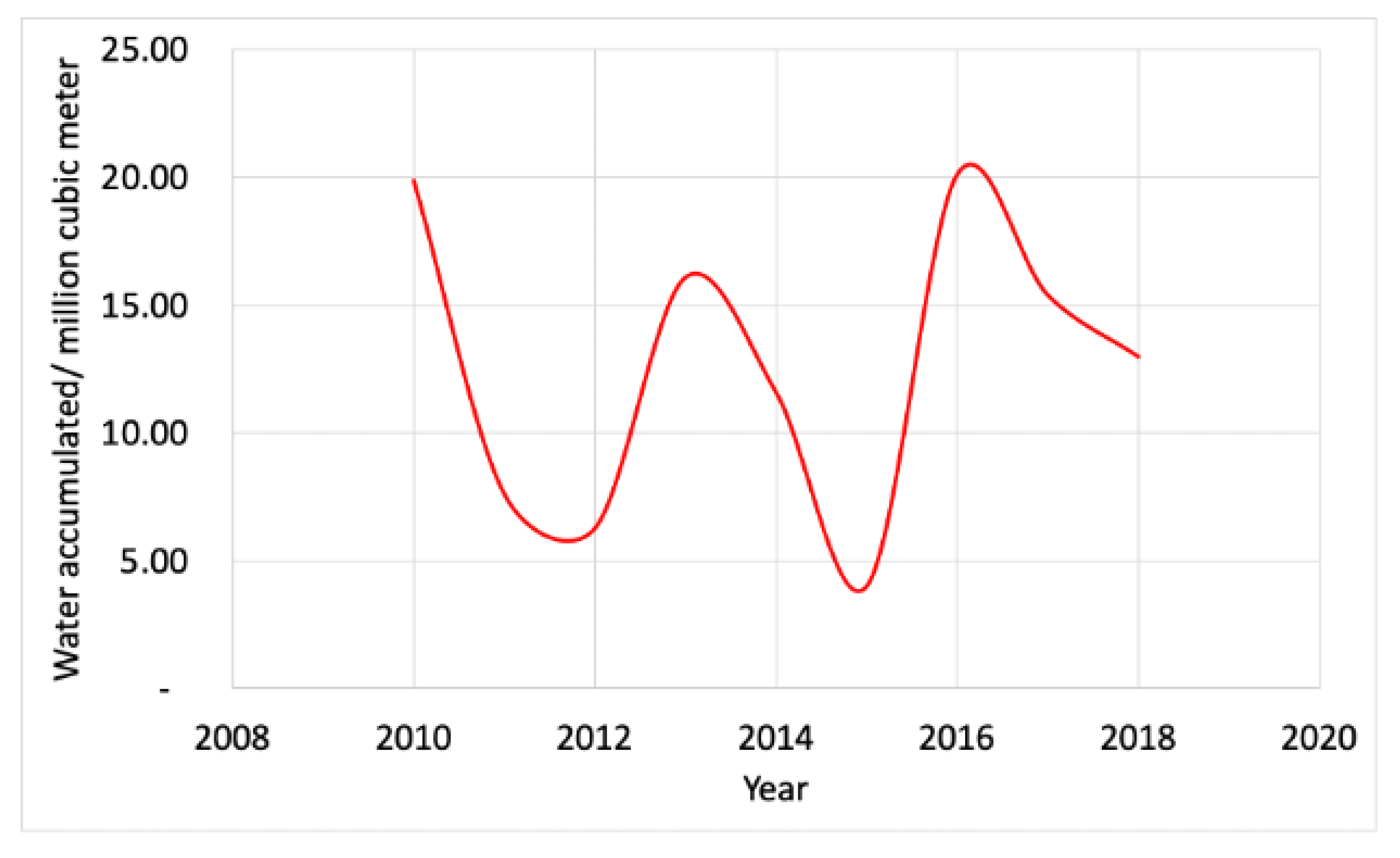

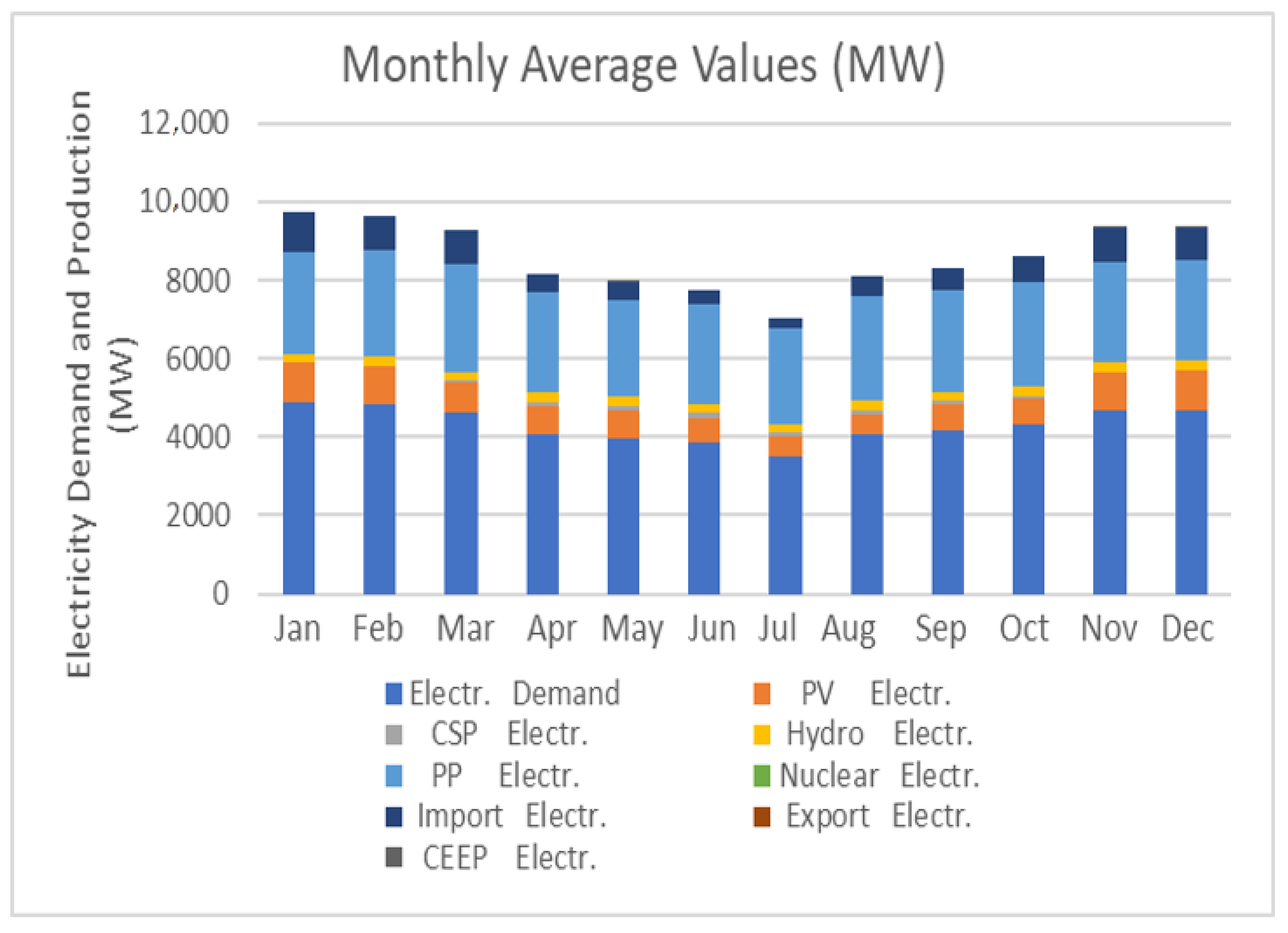

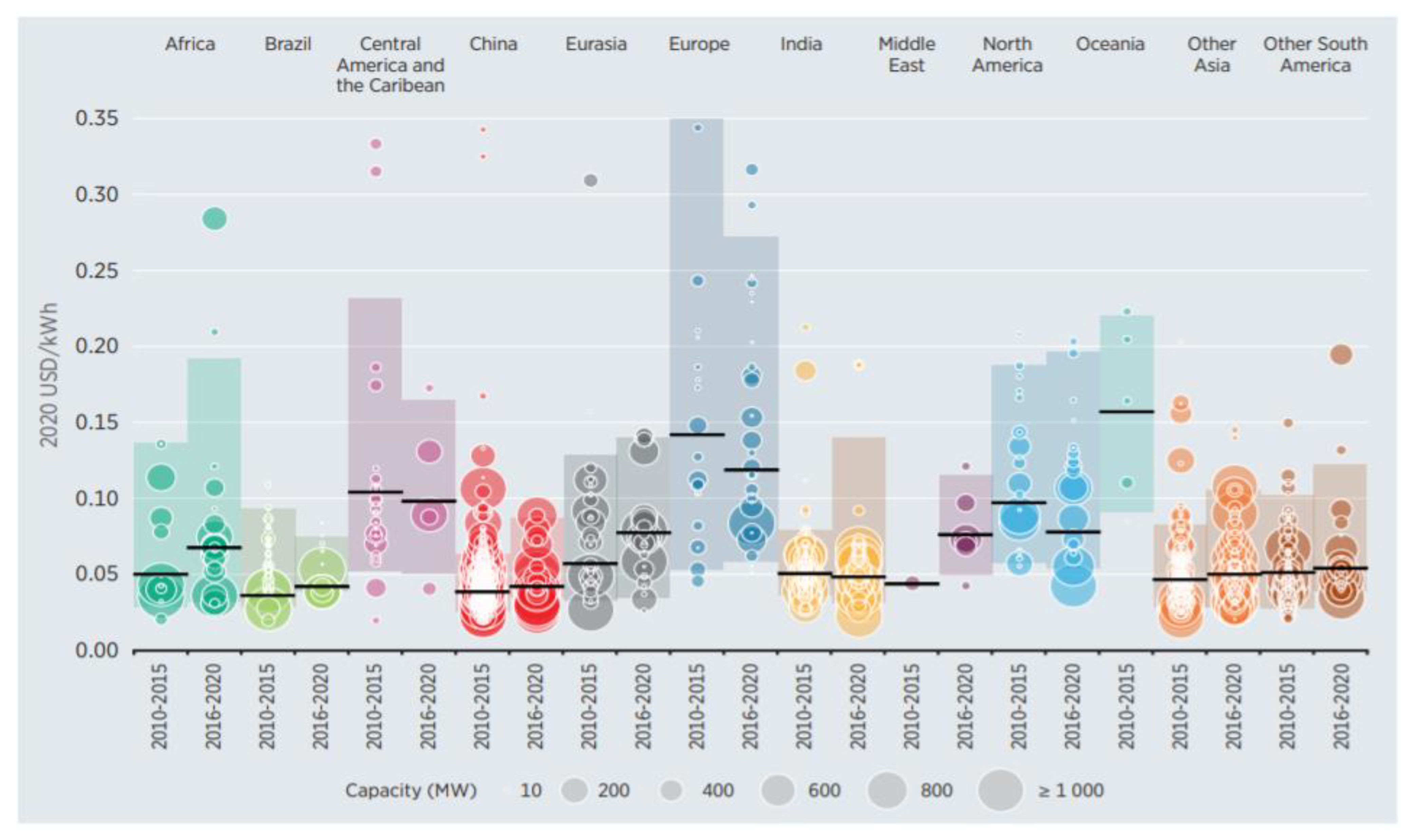

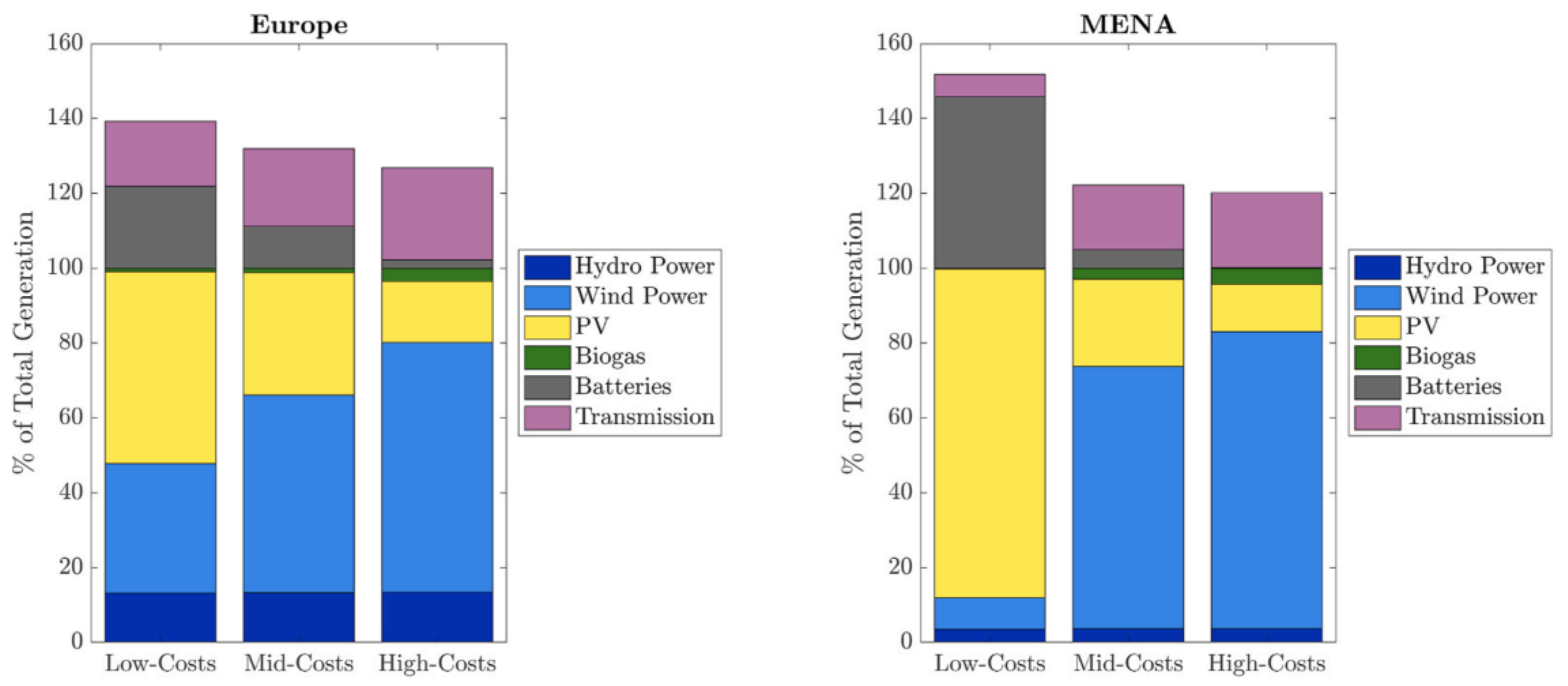
| Advantages | Disadvantages |
|---|---|
| Renewable and clean (since water is the working fluid). | The initial capital cost of PHS installations is sometimes prohibitively high; thus, modular pumped hydro systems are more attractive in terms of direct cost reductions. |
| Has the capability of easily meeting energy demand fluctuations. | Potential site-specific negative environmental impacts, especially on aquatic life. |
| Low maintenance and operational costs. | The electrical energy used to pump water back from the lower reservoir to the upper can come from various energy sources, such as nuclear energy plants that are coal-fired, producing energy that cannot be adjusted to follow the fluctuations of the load. Hence, the new forms of PHS, including ternary pumped hydro and adjustable-speed pumped hydro, could be utilized to overcome this challenge. |
| PHS can be used even if there is little available natural water and store it in artificial dams. | Geographical altitude and amount of water availability. |
| It is sometimes subject to social and environmental issues if the place is of natural and tourist beauty. |
| Africa | |||||||||||
| CAP (MW) | 2010 | 2011 | 2012 | 2013 | 2014 | 2015 | 2016 | 2017 | 2018 | 2019 | 2020 |
| Egypt | 2800 | 2800 | 2800 | 2800 | 2800 | 2800 | 2800 | 2800 | 2832 | 2832 | 2832 |
| Morocco | 1770 | 1770 | 1770 | 1770 | 1770 | 1770 | 1770 | 1770 | 1770 | 1770 | 1770 |
| Sudan | 1593 | 1593 | 1593 | 1593 | 1593 | 1593 | 1593 | 1753 | 1907 | 1907 | 1907 |
| Tunisia | 62 | 62 | 62 | 62 | 62 | 62 | 62 | 62 | 62 | 62 | 62 |
| South Africa | 2135 | 2135 | 2135 | 2135 | 2132 | 2147 | 3146 | 3479 | 3479 | 3479 | 3479 |
| Algeria | 228 | 228 | 228 | 228 | 228 | 228 | 228 | 228 | 228 | 228 | 288 |
| Ethiopia | 1875 | 1972 | 1972 | 1972 | 1972 | 2159 | 2159 | 3817 | 3817 | 3817 | 4071 |
| Asia | |||||||||||
| Afghanistan | 241 | 245 | 273 | 277 | 280 | 284 | 329 | 333 | 333 | 333 | 333 |
| Japan | 47,736 | 48,419 | 48,934 | 48,932 | 49,597 | 50,035 | 50,117 | 50,014 | 50,031 | 50,008 | 50,016 |
| Indonesia | 3741 | 3953 | 4156 | 5177 | 5242 | 5322 | 5666 | 5703 | 5772 | 5976 | 6210 |
| China | 216,057 | 232,980 | 249,470 | 280,440 | 304,860 | 319,530 | 332,070 | 343,775 | 352,261 | 358,040 | 370,160 |
| India | 40,651 | 42,417 | 43,035 | 44,173 | 45,407 | 47,103 | 47,624 | 49,536 | 50,082 | 50,225 | 50,680 |
| Europe | |||||||||||
| Norway | 29,693 | 29,969 | 30,509 | 31,033 | 31,240 | 31,371 | 31,834 | 31,930 | 32,530 | 32,797 | 33,003 |
| France | 25,425 | 25,642 | 25,657 | 25,646 | 25,577 | 25,552 | 25,621 | 25,707 | 25,727 | 25,869 | 25,897 |
| Italy | 21,520 | 21,737 | 21,880 | 22,009 | 22,098 | 22,220 | 22,298 | 22,426 | 22,499 | 22,541 | 22,448 |
| Eurasia | |||||||||||
| Russian Federation | 47,301 | 47,344 | 49,310 | 49,968 | 50,709 | 50,998 | 51,016 | 51,241 | 51,333 | 51,819 | 51,811 |
| Turkey | 15,831 | 17,137 | 19,609 | 22,289 | 23,643 | 25,868 | 26,681 | 27,273 | 28,291 | 28,503 | 30,984 |
| North America | |||||||||||
| USA | 101,023 | 100,943 | 101,107 | 101,589 | 102,162 | 102,240 | 102,692 | 102,703 | 102,847 | 102,769 | 103,058 |
| Canada | 75,573 | 75,537 | 75,537 | 75,537 | 75,537 | 79,420 | 80,259 | 80,831 | 81,004 | 81,053 | 81,058 |
| Mexico | 11,597 | 11,571 | 11,626 | 11,633 | 12,464 | 12,223 | 12,580 | 12,642 | 12,642 | 12,671 | 12,671 |
| South America | |||||||||||
| Brazil | 80,703 | 82,457 | 84,294 | 86,019 | 89,194 | 91,651 | 96,930 | 100,333 | 104,482 | 109,143 | 109,318 |
| Venezuela | 14,624 | 14,624 | 14,624 | 14,881 | 14,881 | 15,138 | 16,521 | 16,521 | 16,521 | 16,521 | 16,521 |
| CAP (MW) | 2010 | 2011 | 2012 | 2013 | 2014 | 2015 | 2016 | 2017 | 2018 | 2019 | 2020 |
|---|---|---|---|---|---|---|---|---|---|---|---|
| World | 99,756 | 102,993 | 105,617 | 106,856 | 108,597 | 111,853 | 116,942 | 119,849 | 120,496 | 120,844 | 121,273 |
| Africa | 1864 | 1864 | 1864 | 1864 | 1864 | 1864 | 2863 | 3196 | 3196 | 3196 | 3196 |
| Morocco | 464 | 464 | 464 | 464 | 464 | 464 | 464 | 464 | 464 | 464 | 464 |
| South Africa | 1400 | 1400 | 1400 | 1400 | 1400 | 1400 | 2399 | 2732 | 2732 | 2732 | 2732 |
| Asia | 49,263 | 52,415 | 54,835 | 56,035 | 57,218 | 58,338 | 61,998 | 64,668 | 65,268 | 65,568 | 65,598 |
| China | 16,930 | 18,383 | 20,333 | 21,533 | 22,110 | 23,030 | 26,690 | 29,390 | 29,990 | 30,290 | 30,320 |
| Chinese Taipei | 2602 | 2602 | 2602 | 2602 | 2602 | 2602 | 2602 | 2602 | 2602 | 2602 | 2602 |
| India | 4786 | 4786 | 4786 | 4786 | 4786 | 4786 | 4786 | 4786 | 4786 | 4786 | 4786 |
| Japan | 19,749 | 20,649 | 21,119 | 21,119 | 21,724 | 21,924 | 21,924 | 21,894 | 21,894 | 21,894 | 21,894 |
| Korea Rep | 3900 | 4700 | 4700 | 4700 | 4700 | 4700 | 4700 | 4700 | 4700 | 4700 | 4700 |
| Philippines | 736 | 736 | 736 | 736 | 736 | 736 | 736 | 736 | 736 | 736 | 736 |
| Thailand | 560 | 560 | 560 | 560 | 560 | 560 | 560 | 560 | 560 | 560 | 560 |
| Eurasia | 1216 | 1216 | 1216 | 1216 | 1216 | 1216 | 1216 | 1216 | 1356 | 1356 | 1356 |
| Russian Fed | 1216 | 1216 | 1216 | 1216 | 1216 | 1216 | 1216 | 1216 | 1356 | 1356 | 1356 |
| Europe | 26,701 | 26,708 | 26,839 | 26,857 | 27,326 | 28,332 | 28,601 | 28,473 | 28,334 | 28,334 | 28,318 |
| Belgium | 1307 | 1307 | 1307 | 1310 | 1310 | 1310 | 1310 | 1310 | 1310 | 1310 | 1310 |
| Bosnia Herzegovina | 420 | 420 | 420 | 420 | 420 | 420 | 420 | 420 | 420 | 420 | 420 |
| Bulgaria | 864 | 864 | 864 | 864 | 864 | 864 | 864 | 864 | 864 | 864 | 864 |
| Czechia | 1147 | 1147 | 1147 | 1172 | 1172 | 1172 | 1172 | 1172 | 1172 | 1172 | 1172 |
| France | 1808 | 1808 | 1808 | 1808 | 1728 | 1728 | 1728 | 1728 | 1728 | 1728 | 1728 |
| Germany | 5811 | 5811 | 5650 | 5650 | 5654 | 5666 | 5578 | 5493 | 5355 | 5355 | 5355 |
| Ireland | 0 | 0 | 292 | 292 | 292 | 292 | 292 | 292 | 292 | 292 | 292 |
| Italy | 3957 | 3957 | 3957 | 3957 | 3982 | 3982 | 3982 | 3940 | 3940 | 3940 | 3940 |
| Lithuania | 760 | 760 | 760 | 760 | 760 | 760 | 760 | 760 | 760 | 760 | 760 |
| Luxembourg | 1100 | 1100 | 1100 | 1100 | 1296 | 1296 | 1296 | 1296 | 1296 | 1296 | 1296 |
| Poland | 1406 | 1406 | 1406 | 1406 | 1406 | 1406 | 1413 | 1423 | 1423 | 1423 | 1423 |
| Romania | 92 | 92 | 92 | 92 | 92 | 92 | 92 | 92 | 92 | 92 | 92 |
| Serbia | 614 | 614 | 614 | 614 | 614 | 614 | 614 | 614 | 614 | 614 | 614 |
| Slovakia | 916 | 916 | 916 | 916 | 916 | 916 | 916 | 916 | 916 | 916 | 916 |
| Slovenia | 180 | 180 | 180 | 180 | 180 | 180 | 180 | 180 | 180 | 180 | 180 |
| Spain | 2449 | 2465 | 2465 | 2455 | 2455 | 3280 | 3321 | 3321 | 3321 | 3321 | 3321 |
| Sweden | 108 | 99 | 99 | 99 | 99 | 99 | 99 | NA | NA | NA | NA |
| Switzerland | 456 | 456 | 456 | 456 | 456 | 469 | 527 | 527 | 527 | 527 | 527 |
| UK | 2444 | 2444 | 2444 | 2444 | 2444 | 2600 | 2600 | 2600 | 2600 | 2600 | 2600 |
| Ukraine | 862 | 862 | 862 | 862 | 1186 | 1186 | 1421 | 1509 | 1509 | 1509 | 1509 |
| European Union (28) | 24,349 | 24,356 | 24,487 | 24,505 | 24,650 | 25,643 | 25,619 | 25,403 | 25,264 | 25,264 | 25,248 |
| Middle East | 240 | 240 | 240 | 240 | 240 | 1280 | 1280 | 1280 | 1280 | 1280 | 1580 |
| Iran IR | 1040 | 1040 | 1040 | 1040 | 1040 | 1040 | |||||
| Iraq | 240 | 240 | 240 | 240 | 240 | 240 | 240 | 240 | 240 | 240 | 240 |
| N America | 18,688 | 18,766 | 18,839 | 18,860 | 18,950 | 19,040 | 19,201 | 19,233 | 19,278 | 19,326 | 19,441 |
| Canada | 177 | 177 | 174 | 174 | 174 | 174 | 174 | 174 | 174 | 174 | 174 |
| USA | 18,511 | 18,589 | 18,665 | 18,686 | 18,776 | 18,866 | 19,027 | 19,059 | 19,104 | 19,152 | 19,267 |
| Oceania | 810 | 810 | 810 | 810 | 810 | 810 | 810 | 810 | 810 | 810 | 810 |
| Australia | 810 | 810 | 810 | 810 | 810 | 810 | 810 | 810 | 810 | 810 | 810 |
| S America | 974 | 974 | 974 | 974 | 974 | 974 | 974 | 974 | 974 | 974 | 974 |
| Argentina | 974 | 974 | 974 | 97 | 974 | 974 | 974 | 974 | 974 | 974 | 974 |
| ICS Power Plant | River | Installed Capacity (MWe) | Operational Since | Cost | Refs. |
|---|---|---|---|---|---|
| Aba Samuel | Akaki | 6.6 | 1932 | USD 14 million | [31] |
| Koka (Awash I) | Awash | 43 | 1960 | USD 34.9 million | [32] |
| Awash II + III | Awash | 64 | 1966 1971 | [32] | |
| Fincha | Fincha | 134 | 1973 | [33] | |
| Fincha Amerti Neshe (FAN) | Amerti/Neshe | 95 | 2011 | USD 147.3 million | [33] |
| Gilgel Gibe I | Gilgel Gibe | 184 | 2004 | [34] | |
| Gilgel Gibe II | Gilgel Gibe /Omo | 420 | 2010 | [35] | |
| Gilgel Gibe III | Omo | 1870 | 2016 | USD 1.870 billion | [35] |
| Koysha | Omo | (2160) | Under construction | [36] | |
| Melka Wakena | Shebelle | 153 | 1989 | [37] | |
| Tana Beles | Beles | 460 | 2010 | USD 500 million | [38] |
| Tekeze | Tekeze | 300 | 2010 | USD 360 million | [39] |
| Tis Abay I + II | Blue Nile | 84.4 | 1953 2001 | [40] | |
| GERD Hidase | Blue Nile | (6450) | Under construction, 65% complete (4/2018) | USD 4.8 billion | [41] |
| Genale Dawa III | Ganale | 254 | 2017 Operational, but out of use for social reasons | USD 451 million | [42] |
| Genale Dawa VI | Ganale | (257) | First quarter of 2020 | USD 451 million | [42] |
| Geba I + II | Gebba | (385) | USD 124 million Geba 2 | [43] | |
| GRHEP | Blue Nile | 6450 | Started: 2011 Pre-generation works are expected to be completed by December 2020; project completion expected by 2022 | USD 4.5 billion | [44] |
| Hydro and Marine | Capacity by Years | Capacity |
| 2018 | 12,726 GWh | |
| 2019/2020 | 2851 MW |
| Name | Installed Capacity (MWe) | Operational Date | Cost | Refs. |
|---|---|---|---|---|
| Aswan High Dam | 2100 MW | Construction: 1960 Completed: 1968 Officially inaugurated: 1971 | USD 1 billion | [50] |
| Assiut | 32 MW annual production: 245 million kWh | Construction began: 1898 Opening date: 1903 | GDP 870,000 4 turbines, each with a capacity of 8 MW | [47] |
| Naga Hammadi | produce 64 MW | 2002 to 2008 | EUR 300M (USD 421 M) | [51] |
| Attaqa | PHS production capacity of 2400 MW | 2024 completion date | USD 2.6 billion | [16] |
| Capacity | |||||
|---|---|---|---|---|---|
| Installed | Nominal | Production | |||
| Number | Name | Year | MW | MW | GWh |
| Operational Plants | |||||
| 1 | Merowe Dam | 2009 | 1250 | 1240 | 5580 |
| 2 | Roseires Dam | 1966 | 280 | 270 | 1050 |
| 5 | Sennar Dam | 1962 | 15 | 12 | 49 |
| 3 | Jebel Aulia Dam | 2003 | 30 | 19 | 55 |
| 4 | Khasm El Girba Dam | 1964 | 10 | 10 | 15 |
| Subtotal A | 1585 | 1551 | 6749 | ||
| Plants Under Construction | |||||
| 5 | Upper Atbra and Sitat | 2015 | 323 | 320 | 834 |
| 6 | Sennar upgrading | 2015 | 11 | 13.7 | 66 |
| Planned plants | |||||
| 7 | Shereik | 420 | 2103 | ||
| 8 | Kajbar | 360 | 1799 | ||
| 9 | Sabaloka | 205 | 866 | ||
| 10 | Dal Low | 648 | 2185 | ||
| 11 | Dagash | 312 | 1349 | ||
| 12 | Mograt | 312 | 1214 | ||
| Subtotal B | 2257 | 9515 | |||
| Total (A + B) | 384 | 16,264 | |||
| Available power% | 38 | 39 | |||
| Name | Generation Capacity | Operational Since | Cost | Refs. |
|---|---|---|---|---|
| Merowe Dam | Annual generation: 5.5 TWh | Construction began: 2004 Opening date: 2009 | EUR 1.2 billion | [53] |
| Roseires Dam | 280 MW | 2012 | USD 396 million | [54] |
| Upper Atbara and Setit | 380 GWh annually | Construction began: 2011 Opening date: 2017 | USD 1.9 billion | [55] |
| Kajbar | Installed capacity: 360 MW | Started 2017—expected completion date unknown | USD 700 million | [56] |
| Plant | Installed Power (MW) | Ref. | Plant | Installed Power (MW) | Ref. |
|---|---|---|---|---|---|
| Darguina | 71.5 | [57] | Ighzernchebel | 2.712 | [59] |
| Ighil Emda | 24 | [60] | Gouriet | 6.425 | [61] |
| Mansouria | 100 | [62] | Bouhanifia | 5.700 | [63] |
| Erraguene | 16 | [64] | Oued Fodda | 15.600 | [65] |
| Souk El Djemaa | 8.085 | [66] | Beni Behde | 3.500 | [67] |
| Tizi Meden | 4.458 | [68] | Tessala | 4.228 | [69] |
| Ghrib | 7 | [70] | Total | 269.208 |
| Hydro and Marine | Capacity by Years | Generation |
| 2018 | 66 MW | |
| 2019–2020 | 66 MW |
| Processed Water Resources | Natural Water Resources |
|---|---|
| –475 million m3 per year of desalinated water –150 million m3 of treated water | –125 million cubic meters per year from seasonal floods –3 million cubic meters per year from permanent springs –22 million cubic meters per year from seasonal springs –20 million cubic meters per year from falaj drainage –109 million cubic meters annually of aquifer recharge |
| No | Name | Capacity (Mm3) | No | Name | Capacity (Mm3) |
|---|---|---|---|---|---|
| 1 | Bih | 7.5 | 13 | Siji | 0.750 |
| 2 | Ham | 7.000 | 14 | Sufni | 0.460 |
| 3 | Hadf | 0.300 | 15 | Burak | 0.280 |
| 4 | Zikt | 3.500 | 16 | Shawkah | 0.272 |
| 5 | Tawayyaien | 19.500 | 17 | Dalm | 0.272 |
| 6 | Hatta | 4.500 | 18 | Safad, Thyib | 0.260 |
| 7 | Shuaib | 20.000 | 19 | Ghalilah | 0.250 |
| 8 | Shi | 3.000 | 20 | Merbih, Kadfaa | 0.242 |
| 9 | Warraiyaa | 5.500 | 21 | Kidaa | 0.220 |
| 10 | Gulfa | 0.125 | 22 | Shaam | 0.152 |
| 11 | Eden | 0.050 | 23 | Ramth | 0.134 |
| 12 | Gheli | 0.120 | 24 | Mai | 0.113 |
| Conventional/Non-Conventional Power Plants | Capacity MW (MegaWatts) | Efficiency (%) | Costs (MDKK) | Location | Reference |
|---|---|---|---|---|---|
| Conventional power plant (Jebel Ali Power Plant) | 2885 | 85.8% | 16,685 | Jebel Ali, Dubai | [78] |
| Dammed Pumped Hydropower | 250 | 80% | 3210 | Hatta, Dubai | [79] |
| Photovoltaic (PV) panels/farms | 800 | NA | 5820 | MBRAK Solar Park | [76] |
| Concentrated Solar Power (CSP) | 700 | NA | 23,690 | MBRAK Solar Park | [80] |
| Year | Electricity Share (TWh/year) |
|---|---|
| Current energy mix | |
| PV | 1.66 |
| CSP | 0.49 |
| PHS | 0 |
| Power plant | 26.87 |
| Import | 8.76 |
| Export | 0 |
| Total | 37.78 |
| 25% renewable share of electricity | |
| PV | 6.74 |
| CSP | 0.49 |
| PHS | 2.07 |
| Power plant | 22.78 |
| Import | 5.69 |
| Export | 0 |
| Total | 37.78 |
Publisher’s Note: MDPI stays neutral with regard to jurisdictional claims in published maps and institutional affiliations. |
© 2022 by the authors. Licensee MDPI, Basel, Switzerland. This article is an open access article distributed under the terms and conditions of the Creative Commons Attribution (CC BY) license (https://creativecommons.org/licenses/by/4.0/).
Share and Cite
Alnaqbi, S.A.; Alasad, S.; Aljaghoub, H.; Alami, A.H.; Abdelkareem, M.A.; Olabi, A.G. Applicability of Hydropower Generation and Pumped Hydro Energy Storage in the Middle East and North Africa. Energies 2022, 15, 2412. https://doi.org/10.3390/en15072412
Alnaqbi SA, Alasad S, Aljaghoub H, Alami AH, Abdelkareem MA, Olabi AG. Applicability of Hydropower Generation and Pumped Hydro Energy Storage in the Middle East and North Africa. Energies. 2022; 15(7):2412. https://doi.org/10.3390/en15072412
Chicago/Turabian StyleAlnaqbi, Shaima A., Shamma Alasad, Haya Aljaghoub, Abdul Hai Alami, Mohammad Ali Abdelkareem, and Abdul Ghani Olabi. 2022. "Applicability of Hydropower Generation and Pumped Hydro Energy Storage in the Middle East and North Africa" Energies 15, no. 7: 2412. https://doi.org/10.3390/en15072412
APA StyleAlnaqbi, S. A., Alasad, S., Aljaghoub, H., Alami, A. H., Abdelkareem, M. A., & Olabi, A. G. (2022). Applicability of Hydropower Generation and Pumped Hydro Energy Storage in the Middle East and North Africa. Energies, 15(7), 2412. https://doi.org/10.3390/en15072412









